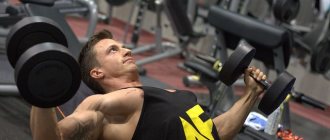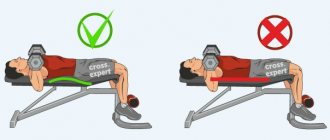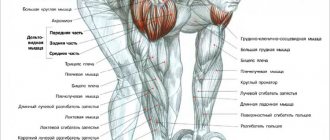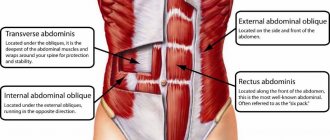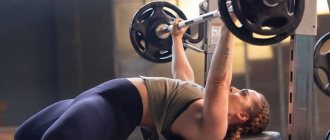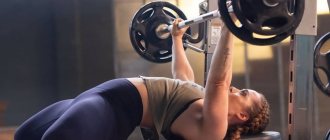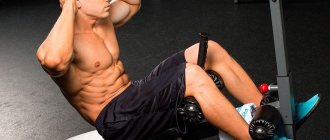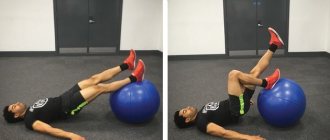There are many chest exercises that you can include in your training program. There really are a lot of them, so trying to master everything at once is obviously a failed idea. To create a competent training regimen, it is enough to study the technique of performing basic movements that help strengthen and build muscle mass.
Taking a dozen effective exercises as a basis, you are sure to achieve good results. The main thing is to train regularly, monitor your technique and combine exercises with a proper diet.
Popular exercises for chest muscles
Many novice athletes take them into account when drawing up a program. Nothing surprising. Everyone wants to become the happy owner of beautiful, developed muscles of the upper body.
However, not all athletes adhere to the correct execution technique and draw up a training plan according to all the rules. As a result, they achieve the desired result, but only at the initial stage. After some time, they face stagnation and lose motivation for sports, giving up training. Therefore, anyone who wants to give their body the desired proportions needs to know what chest exercises need to be performed and how to do it correctly.
Valuable Instructions
Before moving on to the description of the exercises and program, let’s note the importance of the “brain-muscle” connection. Mindful execution of a movement is more effective than mechanical training: in a study evaluating the benefits of verbal instructions, they were found to increase the degree of activation of the pectoral muscles by 22%. That is, in the group of subjects to whom the scientists gave direct instructions to concentrate on a specific muscle, activation of that muscle was higher (with the same weight in the same exercise). True, at maximum weights (80% of 1RM when working on triceps), this effect was no longer detected.
Using free weights
These include dumbbells, barbells, weights and other loose sports equipment. By exercising with such sports equipment, you can become stronger, work on flexibility and coordination. For comparison, stationary strength training machines set the load only on specific muscle areas. Free weights also work the auxiliary muscles, ligaments and tendons.
Bench press horizontally
A very effective basic exercise that allows you to pump up the pectoral muscles, shoulder extensors, and anterior deltoids. Also, when pushing a projectile, an intense contraction of the abs occurs, the legs, back and buttocks become tense. To perform the movement you will need a special bench and, in fact, a barbell.
Take a lying position, spread your legs slightly, focusing on your heels, but without lifting your toes from the floor. Now bring your shoulder blades together, press the back of your head, shoulders and buttocks to the bench.
Grasp the bar with a narrow or wide grip. The first is relevant for pumping the small pectoral muscles, the second - the large ones. Hold the apparatus at arm's length above your chest. As you inhale, lower it down, lightly touching your sternum. As you exhale, lift yourself above yourself again. Your forearms should be perpendicular to the floor surface.
Bent over barbell press
An excellent exercise that allows you to use the muscles of the lower and upper chest area. For comparison, the classic version helps to pump up mainly the central zone.
To begin, set the back of the bench at an angle of 35-40°. Sit on a bench, spread your legs, resting your feet on the floor. The shoulders, back of the head and hips should fit tightly to the bench.
Now grab the bar of the projectile (the grip can be wide or narrow, as in the previous embodiment). While holding your breath after inhaling, lower the barbell to your chest, making a light touch. As you exhale, lift it up.
Dumbbell Bench Press
Basic exercises for the pectoral muscles are suitable for both men and women. Thanks to the use of sports equipment, the most effective pumping of the chest and small stabilizer muscles is carried out. The movement can be performed on a completely horizontal or inclined bench.
To begin, take a lying position. Take the sports equipment in your hands and, moving your elbow joints to the sides, lower the dumbbells to your chest. Now lift them up, straightening your limbs completely. Complete the planned number of sets and reps.
When performing, do not spread the projectiles too wide; try to bring them together as much as possible in the top position.
Lying dumbbell raises
This movement is designed to sculpt the pecs while also stretching and adding volume. When performing, you can lie on a horizontal or inclined bench. Be careful when including it in your training program. This movement is very dangerous. To avoid having to recover from an injury later, leaving training for a long time, do not take too much weight, especially if you are just starting to exercise.
Take a lying position. Bring your shoulder blades together, spread your legs shoulder-width apart, focusing on your heels, but without lifting the toes of your feet from the floor. Hold the dumbbells and lift them up (you can only start and finish the exercise from the top position). As you inhale, spread your arms, slightly bending your elbows. As you exhale, return to the starting position.
Pullover with dumbbell
Another good exercise for training the pectoral muscles. There are several variations of this movement. But if we are talking about working out the chest area, a lying position on an inclined plane will be relevant.
Lie down on a bench, hold the apparatus in front of you in line with your chest. Use a lock grip or place your hands one above the other. The back of the head, buttocks and shoulder blades should be pressed tightly to the surface. Place your feet shoulder-width apart.
Slowly lower the dumbbell behind your head, engaging your shoulder joints. Return to the starting position.
Contraindications
Gymnastics to strengthen the muscles of the back and spine is contraindicated in the following cases:
- exacerbation of chronic pathologies or acute infectious processes;
- serious diseases of the body (oncology, renal failure, hypertension, etc.);
- spinal injuries;
- bleeding;
- severe pain syndrome.
Pregnant women and people who have recently undergone surgery should not perform back strengthening exercises.
Exercises with simulators
Exercising on exercise machines in the gym significantly diversifies your training program. Compared to free weights, they allow you to target a specific muscle area. In addition, for beginners who are just learning the correct technique for chest strength exercises with dumbbells and barbells, it is much easier to train on mechanical (electric or combined) devices.
Bringing hands together on the lower crossover block
It would be appropriate to include this training option last in the training scheme, after completing the basic ones. For the final workout of the pectoral muscles, a cable trainer and bench are used.
To do this, grab the handles of the lower block and sit on the training bench (pre-install its back at an angle of 35-40°). Spread your legs wider than your shoulders, spread your arms slightly bent at the elbow joints to the sides. Exhaling, bring them together, trying to raise them as high as possible. Exhaling, return to the starting position.
Dips
This exercise is an excellent alternative to the incline bench press upside down and does not require support. Experienced athletes should make it the end of their training program; beginners should do it at the beginning of training. The best option is to combine it with regular push-ups.
Jump onto the bars, keeping your body weight on almost straight arms. Lower your shoulders slightly, bend your legs at the knees and cross them together. Bend your elbows and lower yourself down until your shoulders and the floor are parallel. When performing, try to bring your shoulder blades together as much as possible.
Now return to the starting position, pushing yourself up. Do not forget that you should lower while exhaling, and lift while inhaling. This situation applies to all exercises for the pectoral muscles and not only them.
Bench press sitting in front of you in a Smith machine
An effective basic exercise for training the shoulder girdle, allowing you to engage the upper part of the pectoralis major muscle. During the execution, the front and middle deltoids, triceps, and trapezius are involved.
Sit on a bench with a backrest, place your hands on the bar with a wide grip. Place your legs wider than your shoulders, with your feet in full contact with the floor.
Remove the projectile from the rack (hooks), pull it closer to your chest. At this moment the bar should be in its upper area. Therefore, even before performing the exercise, adjust the position of the bench.
As you exhale, press the barbell up. Slowly return to the starting position, lightly touching the bar to your chest.
Reduction of arms in the butterfly simulator
Another effective exercise for men and women, performed using a simulator. Provides a good stretch to the pectoral muscles and gives them definition.
To begin, position yourself in the exercise machine. Straighten your back, making sure it is pressed tightly against the back of the bench. Now grab the handles of the levers, bend your elbows slightly. The forearms are parallel to the floor surface.
Spread your legs wider than your shoulders, look straight ahead. As you exhale, slowly bring your hands together and try to stay in this position for a few seconds. As you inhale, return to the starting position. Feel the chest muscles stretch.
Note! The handles of the machine must be adjusted so that even with the maximum extension of the arms, the muscles still remain tense. When performing, the load should always remain suspended without touching the support.
Hammer Seated Press
Hammer is a lever-type trainer.
This exercise helps develop and shape the pectoralis major muscles. Thanks to the design features of the Hammer, the direction of hand movement is rigidly fixed. The principle of working in it is similar to the bench press, only it is performed in a sitting position.
Sit on the machine bench, press your back against the back, and the handles should be at chest level. Make sure your shoulder blades are squeezed together. Place your feet on the floor.
As you exhale, push the handles forward, straightening your elbow joints. Don't try to press your arms closer to your body, as this will put more stress on your triceps, which you shouldn't do. Also, at the highest point they should not straighten completely. Stay in this position for a few seconds. Exhaling, slowly return to the starting position.
While performing the exercise, do not arch your back. It should remain pressed against the back of the machine bench.
Program for training the pectoral muscles
As an example, let's imagine a couple of training programs that include the best exercises for the pectoral muscles.
When creating a working scheme for yourself, remember that one muscle group should be trained no more than 1-2 times a week.
Program No. 1
Warm up - 5 minutes.
Dumbbell bench press - 3-4 sets of 10-12 reps.
Pullover with a dumbbell - 3-4 sets of 10-12 repetitions.
Incline bench press - 3-4 sets of 6-12 reps.
Bench press in front of you in the Smith machine - 2-3 sets of 10-12 repetitions.
Dips - 4 sets to failure.
Crossover - 4 sets of 15-20 repetitions.
Cool down - 5 minutes.
Program No. 2
Warm up - 5 minutes.
Lying dumbbell raises - 4-5 sets of 8-12 reps.
Horizontal barbell bench press - 2-3 sets of 10-12 repetitions.
Dumbbell pullover - 3-4 sets of 10-12 reps.
Reduction of arms in the butterfly simulator - 3-4 sets of 8-10 repetitions.
Seated press in the Hammer machine - 2-3 sets of 12-15 repetitions.
Crossover - 3 sets of 12-15 repetitions.
Cool down - 5 minutes.
Sportswear and shoes on the adidas promo codes .
Problems and errors
Often we simply don’t know the correct technique, so when doing a chest workout, we work more on our triceps. And when we start training them, it turns out that there is no strength left. The same is true for the lower pectoral muscles.
You need to follow the technique exactly. And remember, every body is individual. Over time, you will learn to feel what works for you and what doesn't. And you can experimentally achieve the performance that is most useful for your case.
When training upside down, some difficulties may arise:
- darkens in the eyes;
- there is noise in the ears;
- intracranial and blood pressure increases.
This is very undesirable for people over 30 years old. Therefore, you should not lower the bench below 30 degrees. Why do you need such extreme conditions? It is better to work on uneven bars and crossover.
It’s easy to check whether you can do bench presses like this or not. Just lie in this position for 30 seconds. Then stand up sharply. If there are ripples in the eyes, noise in the ears, dizziness, it is dangerous for you to train in this position.
Read also
- How to pump up your biceps - exercises for strong biceps
- Training with dumbbells for all muscle groups
- We train the whole body with kettlebells. A set of exercises that can be added to regular exercise
- Chest exercises with dumbbells - top most effective exercises
- How to pump up your arms at home - training your arms at home
- Triceps exercises with dumbbells
- A set of exercises with dumbbells - what exercises to do if you only have free weights at hand
